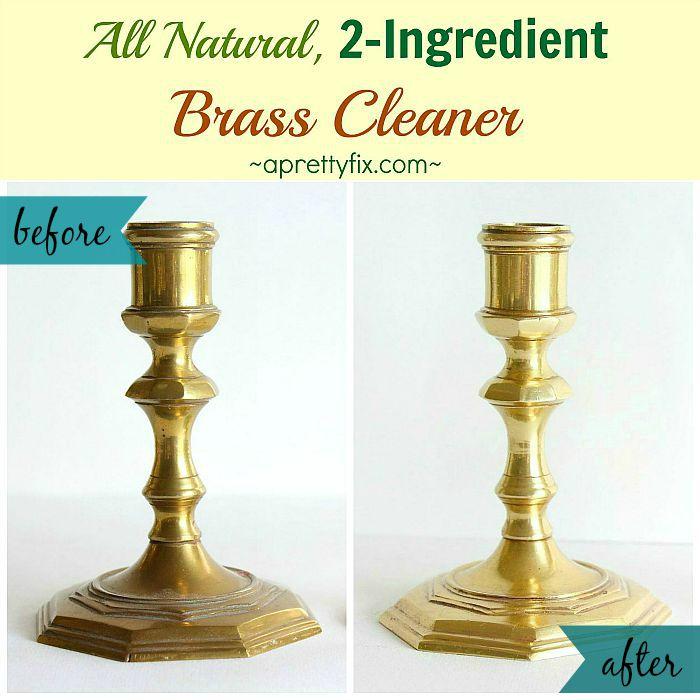How to Clean Brass Naturally
You don't need strong chemicals to regain that warm glow.
ByMelanie Lasoff LevsMelanie Lasoff LevsWriterA writer and editor for over two decades, Melanie Lasoff Levs has written for national outlets including The Washington Post and New York Daily News.Learn about our editorial processUpdated February 15, 2022HomeMade from a combination of zinc and copper, brass is an ancient and popular metal found in cookware, jewelry, musical instruments (brass band, anyone?), and home decorative objects. If your house is of a certain age, many of your doorknobs may be brass—a bonus because of their natural antimicrobial properties.

Cleaning Brass-Plated Items and Lacquered Brass
Like the metals from which it is made, brass also tarnishes easily. What is the best way to clean brass? First, you need to determine if your item is, in fact, made of brass. Hold a magnet to your item. If it sticks, the item is not brass, but most likely brass-plated. Use only water and mild detergent to clean brass-plated items, as anything more abrasive could damage the plating.
If you have a tarnished or dirty brass piece that needs cleaning, how you do so depends on whether it is lacquered—i.e. coated with a protective glossy finish—or non-lacquered brass. Generally, lacquer protects against tarnishing, so there's a good chance your lacquered brass item is simply dirty and needs a good scrubbing with soap and water or a wipe with a damp cloth to get rid of dust.
Cleaning Non-Lacquered Brass
Cleaning non-lacquered brass requires more elbow grease, especially if you're using a natural cleaner. Though there are chemical brass cleaners on the market, these natural ones have fewer strong chemicals, don't emit fumes, and are made with ingredients you likely already have in the kitchen. Avoid steel wool and other scrub pads, as these can scratch the brass.
The housekeeping guru who has been writing the syndicated “Hints from Heloise” column for more than 30 years recommends this acidic kitchen staple. Squirt some ketchup on a clean cloth and rub over tarnished brass. (You can leave it up to an hour if the tarnish is particularly bad.) Then wipe clean with a damp cloth and buff dry. Other tomato-based products work, too, such as tomato paste and sauce.
If your brass item is dusty or dirty rather than tarnished, submerging it in warm soapy water and cleaning with a soft cloth could do the trick. Use a toothbrush to gently scrub extra dirty areas.
These versatile home staples can be combined to make a slightly abrasive paste to clean tarnished brass. Dissolve 1 teaspoon of salt into one half-cup of vinegar, and add flour until the mixture becomes a paste. Rub into the brass, leave for about ten minutes, then rinse with warm water and buff dry.
Vinegar on its own is a powerful cleaner. Danielle Smith Parker, CEO and founder of Detroit Maid, tells Martha Stewart that it's "one of the best natural cleaners." Brass jewelry and cookware can be soaked in a bowl of undiluted vinegar for no more than two hours; rinse and wipe with a microfiber cloth.
And don't be overly concerned about staying on top of all that polishing: "If your goal is to simply prevent tarnishing of an unused brass object, Smith Parker says occasional water rinses with two vinegar soaks per year will do the trick."
Heat a pint of water, and add 2 tablespoons each of salt and white vinegar to create another natural recipe for polishing tarnished brass. Rub the mixture onto the brass, then dry with a clean rag. Alternatively, just try plain warm water with a microfiber cloth; if that's not enough, use a toothbrush to get a bit more scrubbing power.
Straight lemon juice can be used to clean brass and bring back shine. After cleaning with lemon juice, wipe with damp cloth and buff dry. You can also sprinkle salt onto the cut side of a fresh lemon half and rub that into the tarnished item. Another option is to make a paste with 2 parts cream of tartar and 1 part lemon juice; rub onto the brass item and let sit 30 minutes before wiping, rinsing, and buffing dry.
Additional Tips
When might you want to leave your brass piece tarnished? If the brass is an antique, take it to an appraiser before attempting to clean it. The tarnish could add value to your piece, or detract from it if you disturb the item’s natural finish.
After cleaning and polishing, apply a thin layer of oil (linseed or mineral oils work well) to prevent future tarnishing. And try to stay on top of cleaning and polishing so it never gets out of hand; your job will be easier and the results better. You should also avoid touching polished brass items so that the natural oils on your fingers don't rub off and cause it to tarnish.
And if you are disappointed to discover that what you thought was brass is simply brass-plated? Take heart that it is easier to clean—and still can look as warm and shiny as the real thing.








